Adapting MRI Techniques: A Case Study on Claustrophobia and Cancer
VerifiedAdded on 2022/08/12
|9
|2968
|17
Case Study
AI Summary
This case study explores the challenges of performing Magnetic Resonance Imaging (MRI) on a patient suffering from both facial carcinoma and claustrophobia. The patient's conditions necessitate the use of adapted MRI techniques, as the standard 20-channel flex coil MRI is unsuitable due to the enclosed space and potential for panic attacks. The paper critically evaluates the use of 18-channel flex coil MRI and open MRI, considering factors such as patient comfort, image quality, and the need for sedation or anti-anxiety medication. It discusses the prevalence of claustrophobia in the UK and the statistical data related to skin carcinoma and MRI usage. The study also examines the procedures, potential side effects, and the importance of radiologist interaction to ensure patient comfort and accurate diagnosis. The analysis highlights the importance of adapting MRI protocols based on the patient's specific needs and medical history.

Running Head: MEDICAL IMAGING
MAGNETIC RESONANCE IMAGING
Name of the Student
Name of the University
Author note
MAGNETIC RESONANCE IMAGING
Name of the Student
Name of the University
Author note
Paraphrase This Document
Need a fresh take? Get an instant paraphrase of this document with our AI Paraphraser
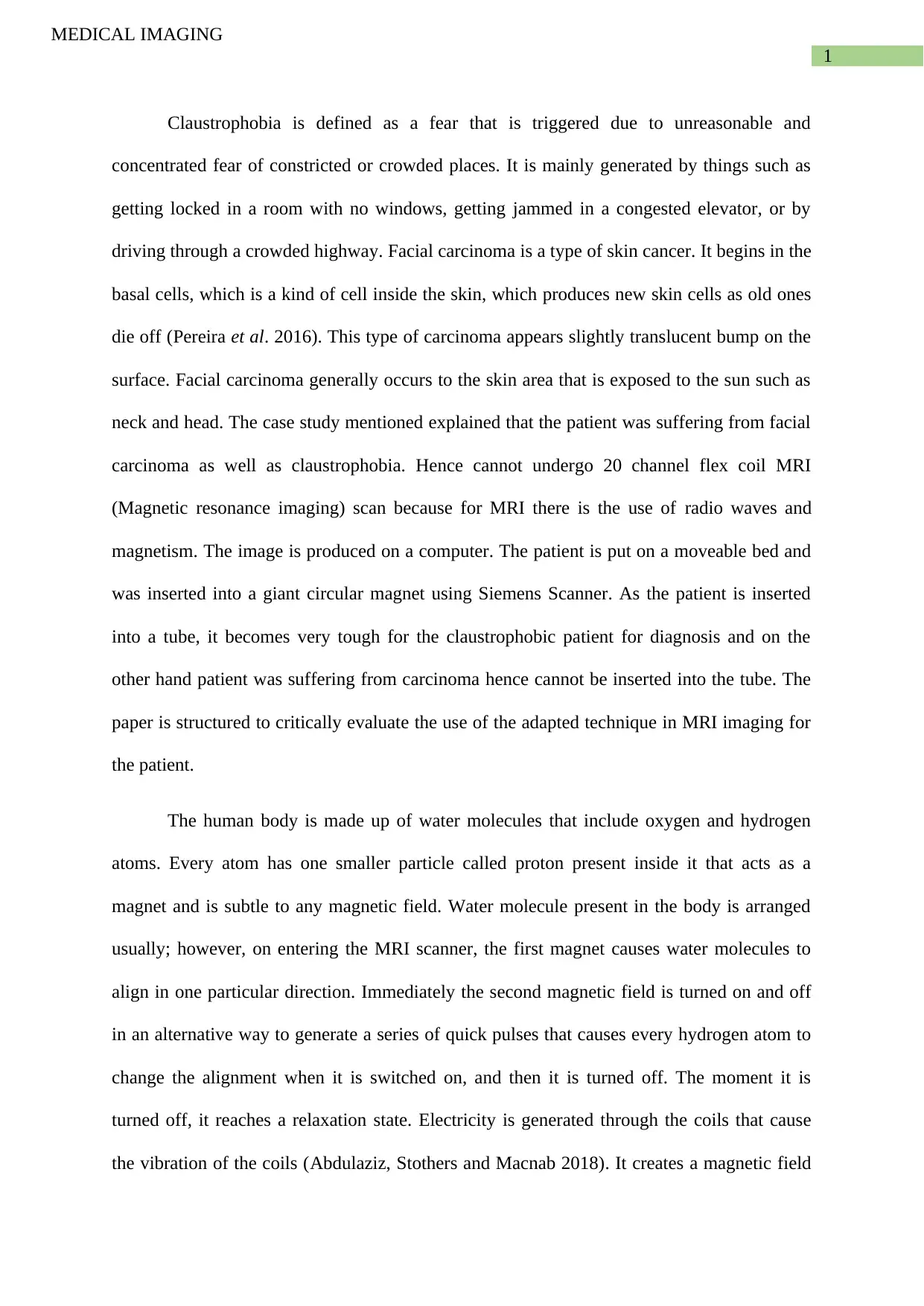
1
MEDICAL IMAGING
Claustrophobia is defined as a fear that is triggered due to unreasonable and
concentrated fear of constricted or crowded places. It is mainly generated by things such as
getting locked in a room with no windows, getting jammed in a congested elevator, or by
driving through a crowded highway. Facial carcinoma is a type of skin cancer. It begins in the
basal cells, which is a kind of cell inside the skin, which produces new skin cells as old ones
die off (Pereira et al. 2016). This type of carcinoma appears slightly translucent bump on the
surface. Facial carcinoma generally occurs to the skin area that is exposed to the sun such as
neck and head. The case study mentioned explained that the patient was suffering from facial
carcinoma as well as claustrophobia. Hence cannot undergo 20 channel flex coil MRI
(Magnetic resonance imaging) scan because for MRI there is the use of radio waves and
magnetism. The image is produced on a computer. The patient is put on a moveable bed and
was inserted into a giant circular magnet using Siemens Scanner. As the patient is inserted
into a tube, it becomes very tough for the claustrophobic patient for diagnosis and on the
other hand patient was suffering from carcinoma hence cannot be inserted into the tube. The
paper is structured to critically evaluate the use of the adapted technique in MRI imaging for
the patient.
The human body is made up of water molecules that include oxygen and hydrogen
atoms. Every atom has one smaller particle called proton present inside it that acts as a
magnet and is subtle to any magnetic field. Water molecule present in the body is arranged
usually; however, on entering the MRI scanner, the first magnet causes water molecules to
align in one particular direction. Immediately the second magnetic field is turned on and off
in an alternative way to generate a series of quick pulses that causes every hydrogen atom to
change the alignment when it is switched on, and then it is turned off. The moment it is
turned off, it reaches a relaxation state. Electricity is generated through the coils that cause
the vibration of the coils (Abdulaziz, Stothers and Macnab 2018). It creates a magnetic field
MEDICAL IMAGING
Claustrophobia is defined as a fear that is triggered due to unreasonable and
concentrated fear of constricted or crowded places. It is mainly generated by things such as
getting locked in a room with no windows, getting jammed in a congested elevator, or by
driving through a crowded highway. Facial carcinoma is a type of skin cancer. It begins in the
basal cells, which is a kind of cell inside the skin, which produces new skin cells as old ones
die off (Pereira et al. 2016). This type of carcinoma appears slightly translucent bump on the
surface. Facial carcinoma generally occurs to the skin area that is exposed to the sun such as
neck and head. The case study mentioned explained that the patient was suffering from facial
carcinoma as well as claustrophobia. Hence cannot undergo 20 channel flex coil MRI
(Magnetic resonance imaging) scan because for MRI there is the use of radio waves and
magnetism. The image is produced on a computer. The patient is put on a moveable bed and
was inserted into a giant circular magnet using Siemens Scanner. As the patient is inserted
into a tube, it becomes very tough for the claustrophobic patient for diagnosis and on the
other hand patient was suffering from carcinoma hence cannot be inserted into the tube. The
paper is structured to critically evaluate the use of the adapted technique in MRI imaging for
the patient.
The human body is made up of water molecules that include oxygen and hydrogen
atoms. Every atom has one smaller particle called proton present inside it that acts as a
magnet and is subtle to any magnetic field. Water molecule present in the body is arranged
usually; however, on entering the MRI scanner, the first magnet causes water molecules to
align in one particular direction. Immediately the second magnetic field is turned on and off
in an alternative way to generate a series of quick pulses that causes every hydrogen atom to
change the alignment when it is switched on, and then it is turned off. The moment it is
turned off, it reaches a relaxation state. Electricity is generated through the coils that cause
the vibration of the coils (Abdulaziz, Stothers and Macnab 2018). It creates a magnetic field
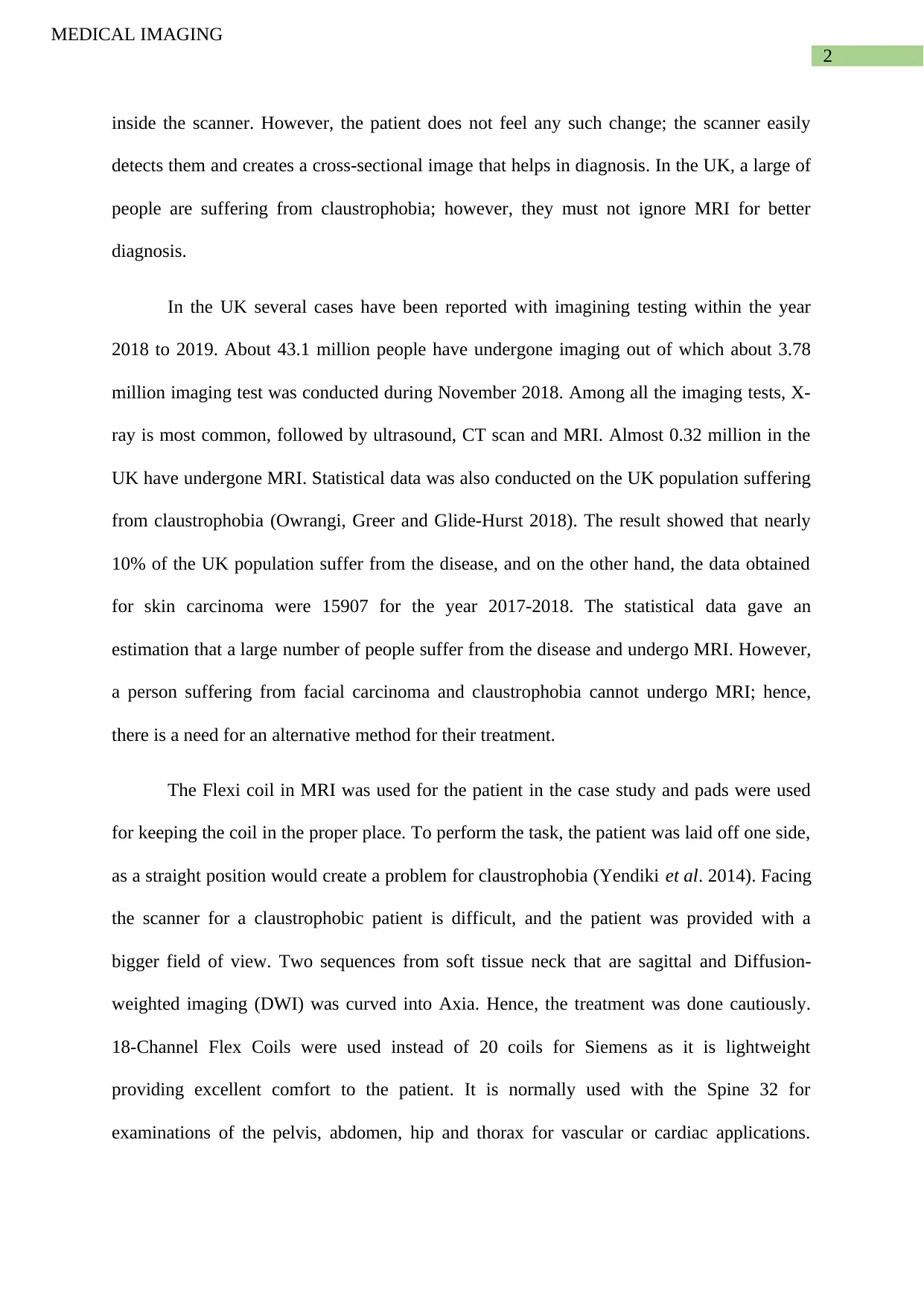
2
MEDICAL IMAGING
inside the scanner. However, the patient does not feel any such change; the scanner easily
detects them and creates a cross-sectional image that helps in diagnosis. In the UK, a large of
people are suffering from claustrophobia; however, they must not ignore MRI for better
diagnosis.
In the UK several cases have been reported with imagining testing within the year
2018 to 2019. About 43.1 million people have undergone imaging out of which about 3.78
million imaging test was conducted during November 2018. Among all the imaging tests, X-
ray is most common, followed by ultrasound, CT scan and MRI. Almost 0.32 million in the
UK have undergone MRI. Statistical data was also conducted on the UK population suffering
from claustrophobia (Owrangi, Greer and Glide-Hurst 2018). The result showed that nearly
10% of the UK population suffer from the disease, and on the other hand, the data obtained
for skin carcinoma were 15907 for the year 2017-2018. The statistical data gave an
estimation that a large number of people suffer from the disease and undergo MRI. However,
a person suffering from facial carcinoma and claustrophobia cannot undergo MRI; hence,
there is a need for an alternative method for their treatment.
The Flexi coil in MRI was used for the patient in the case study and pads were used
for keeping the coil in the proper place. To perform the task, the patient was laid off one side,
as a straight position would create a problem for claustrophobia (Yendiki et al. 2014). Facing
the scanner for a claustrophobic patient is difficult, and the patient was provided with a
bigger field of view. Two sequences from soft tissue neck that are sagittal and Diffusion-
weighted imaging (DWI) was curved into Axia. Hence, the treatment was done cautiously.
18-Channel Flex Coils were used instead of 20 coils for Siemens as it is lightweight
providing excellent comfort to the patient. It is normally used with the Spine 32 for
examinations of the pelvis, abdomen, hip and thorax for vascular or cardiac applications.
MEDICAL IMAGING
inside the scanner. However, the patient does not feel any such change; the scanner easily
detects them and creates a cross-sectional image that helps in diagnosis. In the UK, a large of
people are suffering from claustrophobia; however, they must not ignore MRI for better
diagnosis.
In the UK several cases have been reported with imagining testing within the year
2018 to 2019. About 43.1 million people have undergone imaging out of which about 3.78
million imaging test was conducted during November 2018. Among all the imaging tests, X-
ray is most common, followed by ultrasound, CT scan and MRI. Almost 0.32 million in the
UK have undergone MRI. Statistical data was also conducted on the UK population suffering
from claustrophobia (Owrangi, Greer and Glide-Hurst 2018). The result showed that nearly
10% of the UK population suffer from the disease, and on the other hand, the data obtained
for skin carcinoma were 15907 for the year 2017-2018. The statistical data gave an
estimation that a large number of people suffer from the disease and undergo MRI. However,
a person suffering from facial carcinoma and claustrophobia cannot undergo MRI; hence,
there is a need for an alternative method for their treatment.
The Flexi coil in MRI was used for the patient in the case study and pads were used
for keeping the coil in the proper place. To perform the task, the patient was laid off one side,
as a straight position would create a problem for claustrophobia (Yendiki et al. 2014). Facing
the scanner for a claustrophobic patient is difficult, and the patient was provided with a
bigger field of view. Two sequences from soft tissue neck that are sagittal and Diffusion-
weighted imaging (DWI) was curved into Axia. Hence, the treatment was done cautiously.
18-Channel Flex Coils were used instead of 20 coils for Siemens as it is lightweight
providing excellent comfort to the patient. It is normally used with the Spine 32 for
examinations of the pelvis, abdomen, hip and thorax for vascular or cardiac applications.
⊘ This is a preview!⊘
Do you want full access?
Subscribe today to unlock all pages.

Trusted by 1+ million students worldwide

3
MEDICAL IMAGING
MRI can be closed or open meaning it can be 20 channel flex coil or 18/16 channel flex coil
MRI.
It is noticed that 18 or 20 channel MRI requires some similar steps that need to be
followed. The patient is asked to wear a gown and remove all metal objects and jewellery (De
Vocht et al. 2015). A claustrophobic patient must inform the physician about this as
sometimes physician need to provide them with proper medication before the start of
diagnosis. However, the patient must feel comfortable before MRI scanning. To reduce the
panic, doctor or radiologist need to talk with an individual during the MRI scanning
procedure and answer all the questions that the patient is having. The patient is asked to lie
down on the scanning table with a blanket and cushions. As this patient is claustrophobic and
has a facial tumour, the patient need not to be in a supine position. Headphones or earplugs
are used to cut off the sounds that the scanner is making (Abdulaziz, Stothers and Macnab
2018).
After the MRI scanning is done, the radiologist informs the patient through the intercom, so
check that they are comfortable. The patient needs to be still during a scan that is the most
vital criteria.
The bodily movement in 18 or 20-flex coil scanner would disrupt the result (Schaap et
al. 2014). Sometimes it becomes difficult for the claustrophobic patient to accept the
considerable clanging noise that is coming from the scanner. Sometimes the patient might
have to hold the breadth for better imaging. MRI scanner irrespective of the number of Flexi
coils have side effects. The dye that is used might cause nausea, pain or burning sensation at
the injection point as well as headaches. Sometimes there might be some allergic reactions
leading to itchy or hives in eyes (Kaye et al. 2015). An MRI scanner has two powerful
magnets. These are the utmost necessary parts of the equipment.
MEDICAL IMAGING
MRI can be closed or open meaning it can be 20 channel flex coil or 18/16 channel flex coil
MRI.
It is noticed that 18 or 20 channel MRI requires some similar steps that need to be
followed. The patient is asked to wear a gown and remove all metal objects and jewellery (De
Vocht et al. 2015). A claustrophobic patient must inform the physician about this as
sometimes physician need to provide them with proper medication before the start of
diagnosis. However, the patient must feel comfortable before MRI scanning. To reduce the
panic, doctor or radiologist need to talk with an individual during the MRI scanning
procedure and answer all the questions that the patient is having. The patient is asked to lie
down on the scanning table with a blanket and cushions. As this patient is claustrophobic and
has a facial tumour, the patient need not to be in a supine position. Headphones or earplugs
are used to cut off the sounds that the scanner is making (Abdulaziz, Stothers and Macnab
2018).
After the MRI scanning is done, the radiologist informs the patient through the intercom, so
check that they are comfortable. The patient needs to be still during a scan that is the most
vital criteria.
The bodily movement in 18 or 20-flex coil scanner would disrupt the result (Schaap et
al. 2014). Sometimes it becomes difficult for the claustrophobic patient to accept the
considerable clanging noise that is coming from the scanner. Sometimes the patient might
have to hold the breadth for better imaging. MRI scanner irrespective of the number of Flexi
coils have side effects. The dye that is used might cause nausea, pain or burning sensation at
the injection point as well as headaches. Sometimes there might be some allergic reactions
leading to itchy or hives in eyes (Kaye et al. 2015). An MRI scanner has two powerful
magnets. These are the utmost necessary parts of the equipment.
Paraphrase This Document
Need a fresh take? Get an instant paraphrase of this document with our AI Paraphraser

4
MEDICAL IMAGING
In closed MRI or MRI with 20-channel flex coils have capsule-like space to take good
quality pictures. The machine acts a magnet where the patient lies, and a radio wave is used
that sends signals, which the body receives and reflected, back. The signals that are reflected
are converted to images with the help of a computer (Streitparth et al. 2014). It is then
attached to the scanner. The MRI scanner is of the different magnetic field that is in measured
in Teslas (T) ranging between 0.5T and 0.3T. This provides a detailed image and thereby
helping doctors for easy diagnosis. In some cases, 20-channel Flexi coil MRI is
recommended as it can take pictures that are not possible for other scans (Pereira et al. 2016).
However, this MRI is not suitable for the patient with claustrophobia due to the lack
of comfort and shape. However, the dimension of the scan is highly encapsulated thereby
causes claustrophobia (Sato et al. 2016). As the patient already has claustrophobia, there are
more chances of panic attacks for the patients. If the patient moves inside the capsule it will
lead to inappropriate images; hence it is recommended that the patient must be calm without
any movements. On the other hand, the case study also mentioned that the patient had a
tumour on the forehead, so the capsulated place is not suitable for this patient. Hence, the
patient has to go through an open MRI or 18 channel Flexi coil MRI. Open or 18 channel flex
coil MRI’s are open, but they use a magnet in taking pictures. Unlike closed MRI, they do not
have an enclosed capsule, they use an open magnetic top and top are open on all four sides.
Hence, the patient with claustrophobia would not feel claustrophobic during diagnosis
(Tasaki et al. 2015). They would not undergo any panic attacks. All through the process, the
patient can be perfect shape and order, and hence proper imaging can be done. The case study
also mentioned that the patient has a facial tumour, so open MRI is the best option for the
patient. On the other hand, the structure of Open MRI makes it difficult to take images of
particular places in the body. The pictures obtained for those places are of lesser quality
(Schmidt and Payne 2015).
MEDICAL IMAGING
In closed MRI or MRI with 20-channel flex coils have capsule-like space to take good
quality pictures. The machine acts a magnet where the patient lies, and a radio wave is used
that sends signals, which the body receives and reflected, back. The signals that are reflected
are converted to images with the help of a computer (Streitparth et al. 2014). It is then
attached to the scanner. The MRI scanner is of the different magnetic field that is in measured
in Teslas (T) ranging between 0.5T and 0.3T. This provides a detailed image and thereby
helping doctors for easy diagnosis. In some cases, 20-channel Flexi coil MRI is
recommended as it can take pictures that are not possible for other scans (Pereira et al. 2016).
However, this MRI is not suitable for the patient with claustrophobia due to the lack
of comfort and shape. However, the dimension of the scan is highly encapsulated thereby
causes claustrophobia (Sato et al. 2016). As the patient already has claustrophobia, there are
more chances of panic attacks for the patients. If the patient moves inside the capsule it will
lead to inappropriate images; hence it is recommended that the patient must be calm without
any movements. On the other hand, the case study also mentioned that the patient had a
tumour on the forehead, so the capsulated place is not suitable for this patient. Hence, the
patient has to go through an open MRI or 18 channel Flexi coil MRI. Open or 18 channel flex
coil MRI’s are open, but they use a magnet in taking pictures. Unlike closed MRI, they do not
have an enclosed capsule, they use an open magnetic top and top are open on all four sides.
Hence, the patient with claustrophobia would not feel claustrophobic during diagnosis
(Tasaki et al. 2015). They would not undergo any panic attacks. All through the process, the
patient can be perfect shape and order, and hence proper imaging can be done. The case study
also mentioned that the patient has a facial tumour, so open MRI is the best option for the
patient. On the other hand, the structure of Open MRI makes it difficult to take images of
particular places in the body. The pictures obtained for those places are of lesser quality
(Schmidt and Payne 2015).
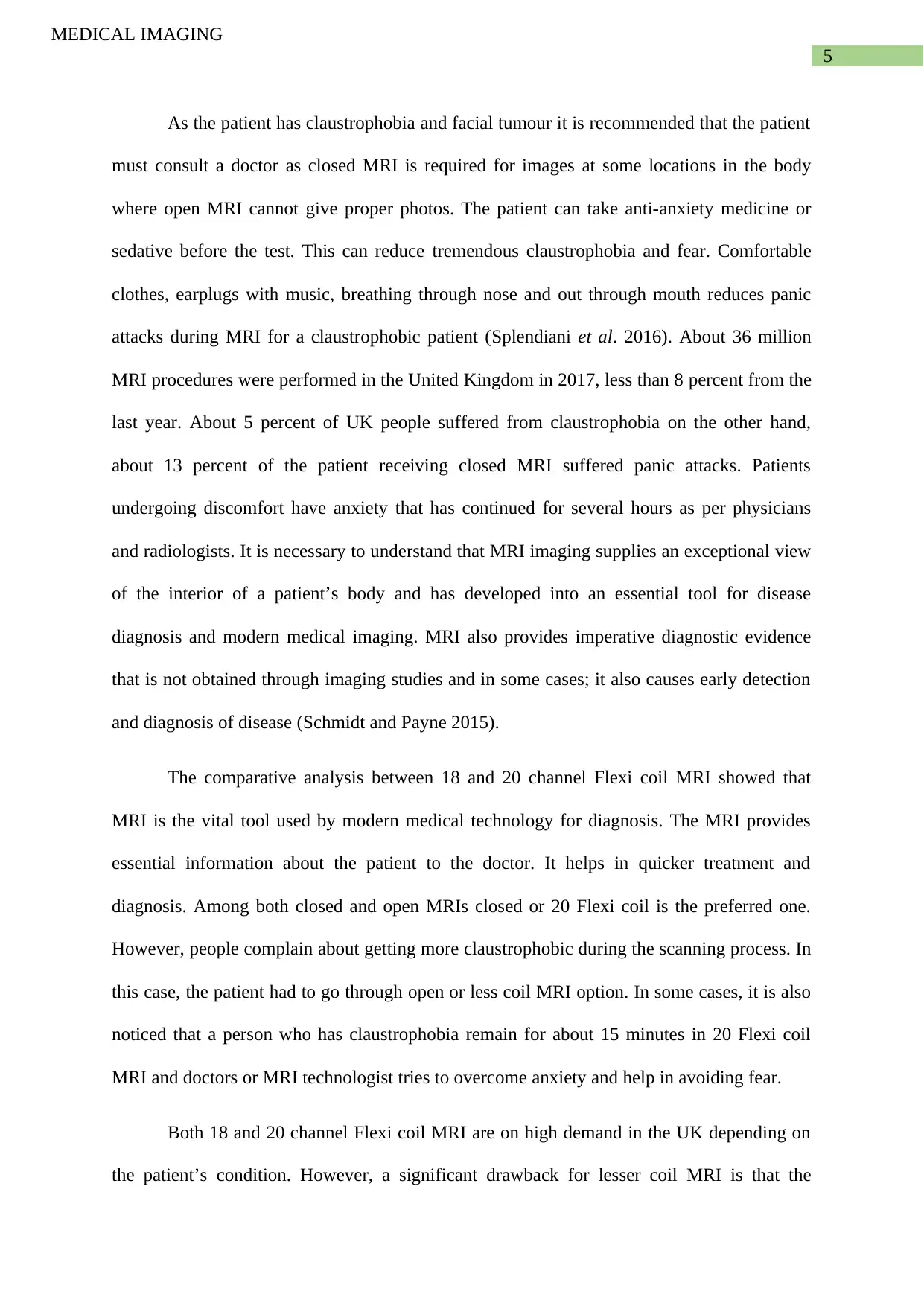
5
MEDICAL IMAGING
As the patient has claustrophobia and facial tumour it is recommended that the patient
must consult a doctor as closed MRI is required for images at some locations in the body
where open MRI cannot give proper photos. The patient can take anti-anxiety medicine or
sedative before the test. This can reduce tremendous claustrophobia and fear. Comfortable
clothes, earplugs with music, breathing through nose and out through mouth reduces panic
attacks during MRI for a claustrophobic patient (Splendiani et al. 2016). About 36 million
MRI procedures were performed in the United Kingdom in 2017, less than 8 percent from the
last year. About 5 percent of UK people suffered from claustrophobia on the other hand,
about 13 percent of the patient receiving closed MRI suffered panic attacks. Patients
undergoing discomfort have anxiety that has continued for several hours as per physicians
and radiologists. It is necessary to understand that MRI imaging supplies an exceptional view
of the interior of a patient’s body and has developed into an essential tool for disease
diagnosis and modern medical imaging. MRI also provides imperative diagnostic evidence
that is not obtained through imaging studies and in some cases; it also causes early detection
and diagnosis of disease (Schmidt and Payne 2015).
The comparative analysis between 18 and 20 channel Flexi coil MRI showed that
MRI is the vital tool used by modern medical technology for diagnosis. The MRI provides
essential information about the patient to the doctor. It helps in quicker treatment and
diagnosis. Among both closed and open MRIs closed or 20 Flexi coil is the preferred one.
However, people complain about getting more claustrophobic during the scanning process. In
this case, the patient had to go through open or less coil MRI option. In some cases, it is also
noticed that a person who has claustrophobia remain for about 15 minutes in 20 Flexi coil
MRI and doctors or MRI technologist tries to overcome anxiety and help in avoiding fear.
Both 18 and 20 channel Flexi coil MRI are on high demand in the UK depending on
the patient’s condition. However, a significant drawback for lesser coil MRI is that the
MEDICAL IMAGING
As the patient has claustrophobia and facial tumour it is recommended that the patient
must consult a doctor as closed MRI is required for images at some locations in the body
where open MRI cannot give proper photos. The patient can take anti-anxiety medicine or
sedative before the test. This can reduce tremendous claustrophobia and fear. Comfortable
clothes, earplugs with music, breathing through nose and out through mouth reduces panic
attacks during MRI for a claustrophobic patient (Splendiani et al. 2016). About 36 million
MRI procedures were performed in the United Kingdom in 2017, less than 8 percent from the
last year. About 5 percent of UK people suffered from claustrophobia on the other hand,
about 13 percent of the patient receiving closed MRI suffered panic attacks. Patients
undergoing discomfort have anxiety that has continued for several hours as per physicians
and radiologists. It is necessary to understand that MRI imaging supplies an exceptional view
of the interior of a patient’s body and has developed into an essential tool for disease
diagnosis and modern medical imaging. MRI also provides imperative diagnostic evidence
that is not obtained through imaging studies and in some cases; it also causes early detection
and diagnosis of disease (Schmidt and Payne 2015).
The comparative analysis between 18 and 20 channel Flexi coil MRI showed that
MRI is the vital tool used by modern medical technology for diagnosis. The MRI provides
essential information about the patient to the doctor. It helps in quicker treatment and
diagnosis. Among both closed and open MRIs closed or 20 Flexi coil is the preferred one.
However, people complain about getting more claustrophobic during the scanning process. In
this case, the patient had to go through open or less coil MRI option. In some cases, it is also
noticed that a person who has claustrophobia remain for about 15 minutes in 20 Flexi coil
MRI and doctors or MRI technologist tries to overcome anxiety and help in avoiding fear.
Both 18 and 20 channel Flexi coil MRI are on high demand in the UK depending on
the patient’s condition. However, a significant drawback for lesser coil MRI is that the
⊘ This is a preview!⊘
Do you want full access?
Subscribe today to unlock all pages.

Trusted by 1+ million students worldwide
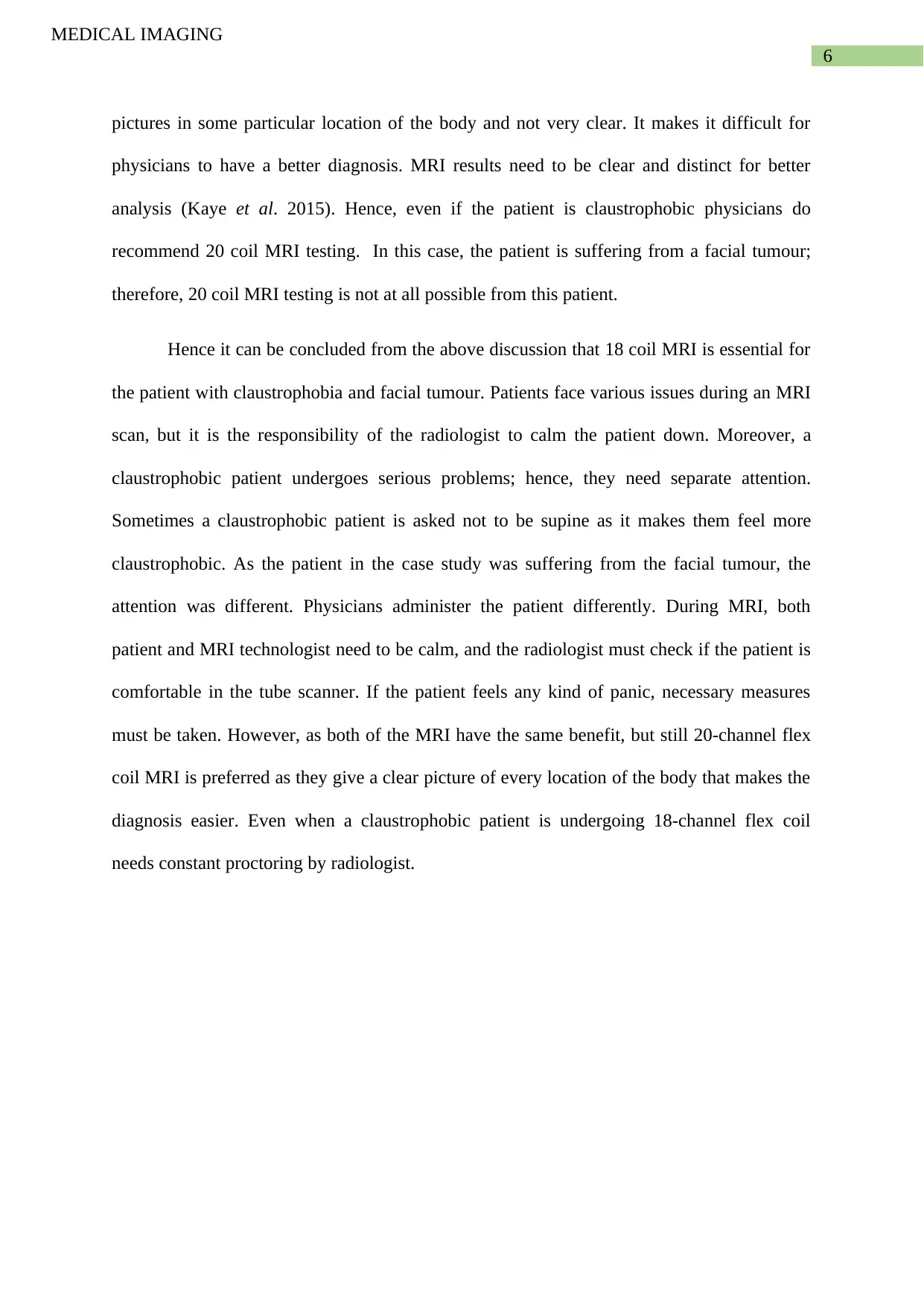
6
MEDICAL IMAGING
pictures in some particular location of the body and not very clear. It makes it difficult for
physicians to have a better diagnosis. MRI results need to be clear and distinct for better
analysis (Kaye et al. 2015). Hence, even if the patient is claustrophobic physicians do
recommend 20 coil MRI testing. In this case, the patient is suffering from a facial tumour;
therefore, 20 coil MRI testing is not at all possible from this patient.
Hence it can be concluded from the above discussion that 18 coil MRI is essential for
the patient with claustrophobia and facial tumour. Patients face various issues during an MRI
scan, but it is the responsibility of the radiologist to calm the patient down. Moreover, a
claustrophobic patient undergoes serious problems; hence, they need separate attention.
Sometimes a claustrophobic patient is asked not to be supine as it makes them feel more
claustrophobic. As the patient in the case study was suffering from the facial tumour, the
attention was different. Physicians administer the patient differently. During MRI, both
patient and MRI technologist need to be calm, and the radiologist must check if the patient is
comfortable in the tube scanner. If the patient feels any kind of panic, necessary measures
must be taken. However, as both of the MRI have the same benefit, but still 20-channel flex
coil MRI is preferred as they give a clear picture of every location of the body that makes the
diagnosis easier. Even when a claustrophobic patient is undergoing 18-channel flex coil
needs constant proctoring by radiologist.
MEDICAL IMAGING
pictures in some particular location of the body and not very clear. It makes it difficult for
physicians to have a better diagnosis. MRI results need to be clear and distinct for better
analysis (Kaye et al. 2015). Hence, even if the patient is claustrophobic physicians do
recommend 20 coil MRI testing. In this case, the patient is suffering from a facial tumour;
therefore, 20 coil MRI testing is not at all possible from this patient.
Hence it can be concluded from the above discussion that 18 coil MRI is essential for
the patient with claustrophobia and facial tumour. Patients face various issues during an MRI
scan, but it is the responsibility of the radiologist to calm the patient down. Moreover, a
claustrophobic patient undergoes serious problems; hence, they need separate attention.
Sometimes a claustrophobic patient is asked not to be supine as it makes them feel more
claustrophobic. As the patient in the case study was suffering from the facial tumour, the
attention was different. Physicians administer the patient differently. During MRI, both
patient and MRI technologist need to be calm, and the radiologist must check if the patient is
comfortable in the tube scanner. If the patient feels any kind of panic, necessary measures
must be taken. However, as both of the MRI have the same benefit, but still 20-channel flex
coil MRI is preferred as they give a clear picture of every location of the body that makes the
diagnosis easier. Even when a claustrophobic patient is undergoing 18-channel flex coil
needs constant proctoring by radiologist.
Paraphrase This Document
Need a fresh take? Get an instant paraphrase of this document with our AI Paraphraser
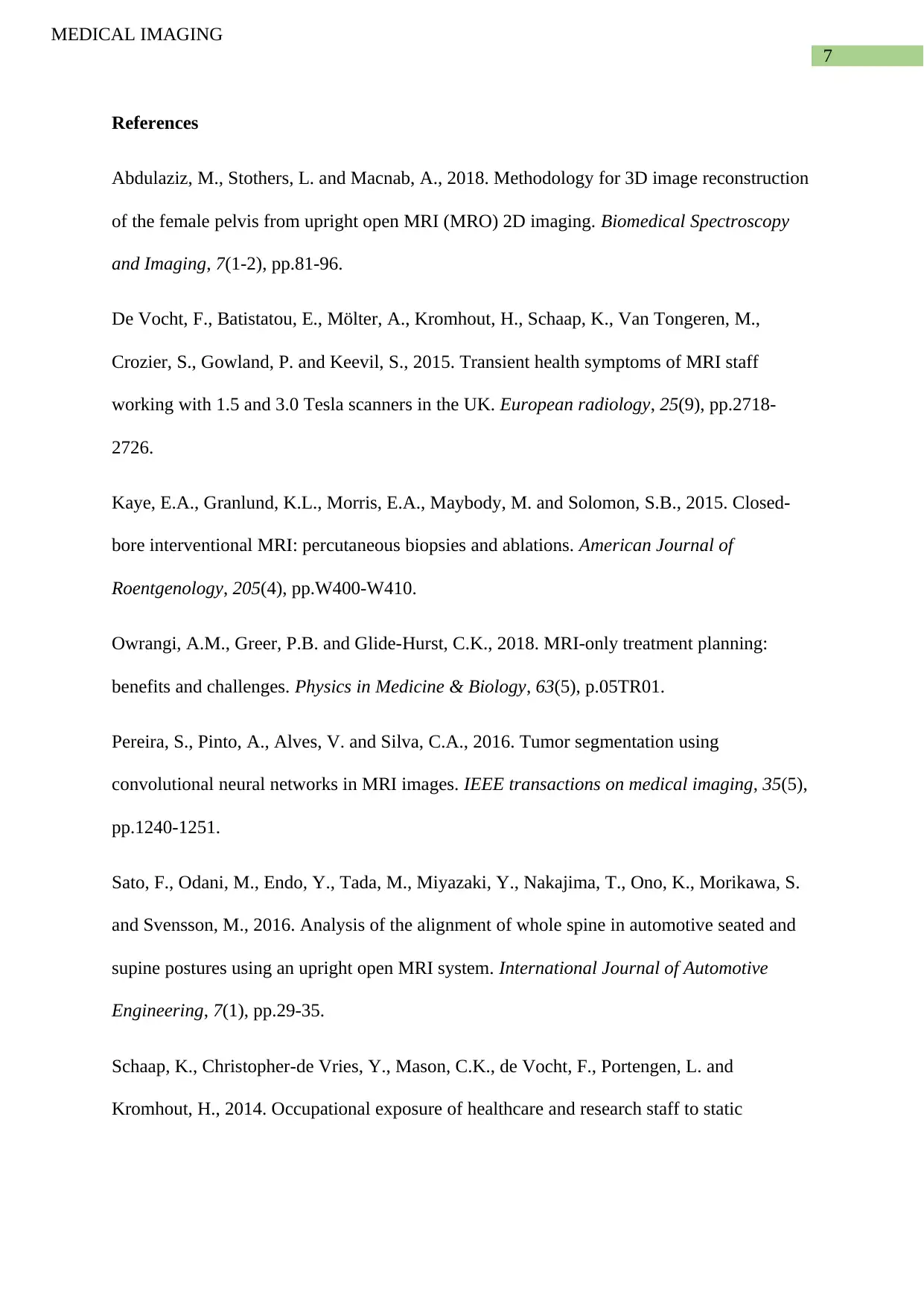
7
MEDICAL IMAGING
References
Abdulaziz, M., Stothers, L. and Macnab, A., 2018. Methodology for 3D image reconstruction
of the female pelvis from upright open MRI (MRO) 2D imaging. Biomedical Spectroscopy
and Imaging, 7(1-2), pp.81-96.
De Vocht, F., Batistatou, E., Mölter, A., Kromhout, H., Schaap, K., Van Tongeren, M.,
Crozier, S., Gowland, P. and Keevil, S., 2015. Transient health symptoms of MRI staff
working with 1.5 and 3.0 Tesla scanners in the UK. European radiology, 25(9), pp.2718-
2726.
Kaye, E.A., Granlund, K.L., Morris, E.A., Maybody, M. and Solomon, S.B., 2015. Closed-
bore interventional MRI: percutaneous biopsies and ablations. American Journal of
Roentgenology, 205(4), pp.W400-W410.
Owrangi, A.M., Greer, P.B. and Glide-Hurst, C.K., 2018. MRI-only treatment planning:
benefits and challenges. Physics in Medicine & Biology, 63(5), p.05TR01.
Pereira, S., Pinto, A., Alves, V. and Silva, C.A., 2016. Tumor segmentation using
convolutional neural networks in MRI images. IEEE transactions on medical imaging, 35(5),
pp.1240-1251.
Sato, F., Odani, M., Endo, Y., Tada, M., Miyazaki, Y., Nakajima, T., Ono, K., Morikawa, S.
and Svensson, M., 2016. Analysis of the alignment of whole spine in automotive seated and
supine postures using an upright open MRI system. International Journal of Automotive
Engineering, 7(1), pp.29-35.
Schaap, K., Christopher-de Vries, Y., Mason, C.K., de Vocht, F., Portengen, L. and
Kromhout, H., 2014. Occupational exposure of healthcare and research staff to static
MEDICAL IMAGING
References
Abdulaziz, M., Stothers, L. and Macnab, A., 2018. Methodology for 3D image reconstruction
of the female pelvis from upright open MRI (MRO) 2D imaging. Biomedical Spectroscopy
and Imaging, 7(1-2), pp.81-96.
De Vocht, F., Batistatou, E., Mölter, A., Kromhout, H., Schaap, K., Van Tongeren, M.,
Crozier, S., Gowland, P. and Keevil, S., 2015. Transient health symptoms of MRI staff
working with 1.5 and 3.0 Tesla scanners in the UK. European radiology, 25(9), pp.2718-
2726.
Kaye, E.A., Granlund, K.L., Morris, E.A., Maybody, M. and Solomon, S.B., 2015. Closed-
bore interventional MRI: percutaneous biopsies and ablations. American Journal of
Roentgenology, 205(4), pp.W400-W410.
Owrangi, A.M., Greer, P.B. and Glide-Hurst, C.K., 2018. MRI-only treatment planning:
benefits and challenges. Physics in Medicine & Biology, 63(5), p.05TR01.
Pereira, S., Pinto, A., Alves, V. and Silva, C.A., 2016. Tumor segmentation using
convolutional neural networks in MRI images. IEEE transactions on medical imaging, 35(5),
pp.1240-1251.
Sato, F., Odani, M., Endo, Y., Tada, M., Miyazaki, Y., Nakajima, T., Ono, K., Morikawa, S.
and Svensson, M., 2016. Analysis of the alignment of whole spine in automotive seated and
supine postures using an upright open MRI system. International Journal of Automotive
Engineering, 7(1), pp.29-35.
Schaap, K., Christopher-de Vries, Y., Mason, C.K., de Vocht, F., Portengen, L. and
Kromhout, H., 2014. Occupational exposure of healthcare and research staff to static
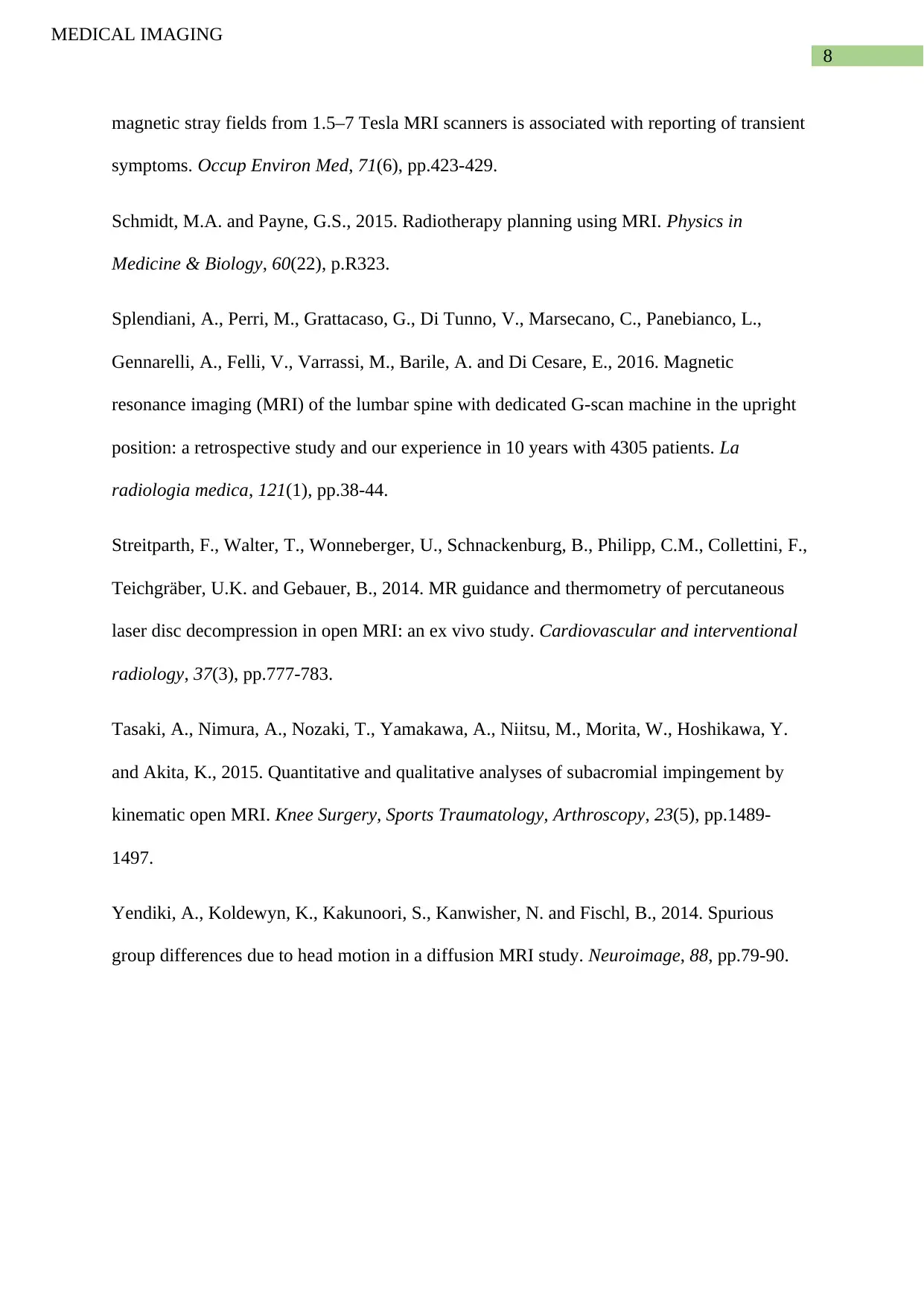
8
MEDICAL IMAGING
magnetic stray fields from 1.5–7 Tesla MRI scanners is associated with reporting of transient
symptoms. Occup Environ Med, 71(6), pp.423-429.
Schmidt, M.A. and Payne, G.S., 2015. Radiotherapy planning using MRI. Physics in
Medicine & Biology, 60(22), p.R323.
Splendiani, A., Perri, M., Grattacaso, G., Di Tunno, V., Marsecano, C., Panebianco, L.,
Gennarelli, A., Felli, V., Varrassi, M., Barile, A. and Di Cesare, E., 2016. Magnetic
resonance imaging (MRI) of the lumbar spine with dedicated G-scan machine in the upright
position: a retrospective study and our experience in 10 years with 4305 patients. La
radiologia medica, 121(1), pp.38-44.
Streitparth, F., Walter, T., Wonneberger, U., Schnackenburg, B., Philipp, C.M., Collettini, F.,
Teichgräber, U.K. and Gebauer, B., 2014. MR guidance and thermometry of percutaneous
laser disc decompression in open MRI: an ex vivo study. Cardiovascular and interventional
radiology, 37(3), pp.777-783.
Tasaki, A., Nimura, A., Nozaki, T., Yamakawa, A., Niitsu, M., Morita, W., Hoshikawa, Y.
and Akita, K., 2015. Quantitative and qualitative analyses of subacromial impingement by
kinematic open MRI. Knee Surgery, Sports Traumatology, Arthroscopy, 23(5), pp.1489-
1497.
Yendiki, A., Koldewyn, K., Kakunoori, S., Kanwisher, N. and Fischl, B., 2014. Spurious
group differences due to head motion in a diffusion MRI study. Neuroimage, 88, pp.79-90.
MEDICAL IMAGING
magnetic stray fields from 1.5–7 Tesla MRI scanners is associated with reporting of transient
symptoms. Occup Environ Med, 71(6), pp.423-429.
Schmidt, M.A. and Payne, G.S., 2015. Radiotherapy planning using MRI. Physics in
Medicine & Biology, 60(22), p.R323.
Splendiani, A., Perri, M., Grattacaso, G., Di Tunno, V., Marsecano, C., Panebianco, L.,
Gennarelli, A., Felli, V., Varrassi, M., Barile, A. and Di Cesare, E., 2016. Magnetic
resonance imaging (MRI) of the lumbar spine with dedicated G-scan machine in the upright
position: a retrospective study and our experience in 10 years with 4305 patients. La
radiologia medica, 121(1), pp.38-44.
Streitparth, F., Walter, T., Wonneberger, U., Schnackenburg, B., Philipp, C.M., Collettini, F.,
Teichgräber, U.K. and Gebauer, B., 2014. MR guidance and thermometry of percutaneous
laser disc decompression in open MRI: an ex vivo study. Cardiovascular and interventional
radiology, 37(3), pp.777-783.
Tasaki, A., Nimura, A., Nozaki, T., Yamakawa, A., Niitsu, M., Morita, W., Hoshikawa, Y.
and Akita, K., 2015. Quantitative and qualitative analyses of subacromial impingement by
kinematic open MRI. Knee Surgery, Sports Traumatology, Arthroscopy, 23(5), pp.1489-
1497.
Yendiki, A., Koldewyn, K., Kakunoori, S., Kanwisher, N. and Fischl, B., 2014. Spurious
group differences due to head motion in a diffusion MRI study. Neuroimage, 88, pp.79-90.
⊘ This is a preview!⊘
Do you want full access?
Subscribe today to unlock all pages.

Trusted by 1+ million students worldwide
1 out of 9
Your All-in-One AI-Powered Toolkit for Academic Success.
+13062052269
info@desklib.com
Available 24*7 on WhatsApp / Email
![[object Object]](/_next/static/media/star-bottom.7253800d.svg)
Unlock your academic potential
Copyright © 2020–2025 A2Z Services. All Rights Reserved. Developed and managed by ZUCOL.